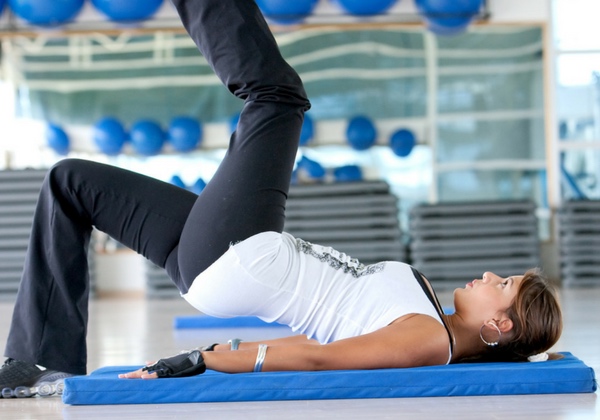• Guest post from Lana Johnson, BPS Tensegrity •
As a physiotherapist and Pilates instructor, I am very aware and constantly assessing various pre and post-natal pelvic floor’s. After speaking with doctors and midwives, reading endless hospital brochures, online resources and books, I get the message … it is vital to look after our pelvic floor during pregnancy and beyond … but what exactly should we be doing?
What is my pelvic floor and why is it important?
The pelvic floor is a group of muscles that act like a sling or trampoline that support the bladder, uterus and anus. They also need to be adaptable to our everyday movements – being able to contract and relax for optimal bowel and bladder function. The pelvic floor works as part of a team including the core muscles and the diaphragm. This trio work together to create ultimate function and stability and if one, two or even all three become compromised, it can lead to dysfunction, such as incontinence, reduced spinal stability and inefficient breathing patterns.
For a more detailed overview of the pelvic floor, please visit http://www.bpstensegrity.com.au/2015/11/episode-005-pelvic-floor-exercises
to have a listen to our podcast.
How does pregnancy change things?
Of course achieving optimal pelvic floor function becomes more and more challenging the further we move through our pregnancy. As the baby grows, so do our bellies meaning our core muscles are stretched/distorted and struggle to function in the stabilising manner they did pre-bub. Our internal organs start to become squashed eventually impeding on our diaphragm and reducing how much it can descend when we inhale. The bubs weight also pushes down onto the bladder and pelvic floor, with the most noticeable symptom being the increased need to urinate.
The pelvic floor deserves a special mention as not only does it have to put up with 9 months of pressure from the ever growing bub but it is very significant in the natural birthing process, hence it definitely needs attention, time and TLC. Of course prevention is better than cure, therefore by connecting to your pelvic floor early on and discovering its capabilities, you can teach the pelvic floor to be adaptable, avoid any bowel or bladder continence issues during pregnancy and beyond, be supportive to our ever changing environments and of course assist us in the natural birthing process.
So….what should we be doing?
In order to answer this question, there are a few factors to take into consideration:
- We are all different.
- Each woman has been on her own journey and we all lead different lifestyles, therefore it is very challenging to specify a one size fits all protocol of pelvic floor exercises.
- Exercise prescription must be based on the individual.
- This will enable you to determine the purpose of the pelvic floor exercises, i.e. to connect to a weakened pelvic floor or to relax or let go of an overactive pelvic floor. Ideally, each of us would undergo a thorough assessment with a physiotherapist to determine our individual exercise needs. However here are a few exercises that are very relevant during pregnancy: (Please note that lying on your back during pregnancy can make you light-headed or dizzy due to the uterus pressure on the vena cava. If you experience this, please choose a different position to connect to your pelvic floor.)
- Connecting to our pelvic floor.
- Lie flat on your back with knees bent and feet flat. Breathe. As you inhale feel the diaphragm descend as oxygen flows into our lungs. The increase in intra-abdominal pressure causes the pelvic floor to descend simultaneously. Both the diaphragm and pelvic floor ascend as we exhale
- Once you feel this subtle movement – try in different orientations i.e. sitting, 4 point kneeling, lying on your tummy and standing.
- Gentle pelvic floor toning – to counteract the general softening, pressure and weakening that could occur during birth.
- Start lying on your back as above. As you breath naturally, gently feel your pelvic floor lift, similar to the feeling of stopping the flow of urine.
- Practice a slow controlled lift, holding that position and then add fast squeezes, perhaps once per day, starting with 5 repetitions. Change orientation as above to challenge yourself in more functional positions.
- Ensure you are lifting the front and back part of your pelvic floor – you should feel the vagina lift too, not just the anus.
- Learn to let go.
- Important for women with an overactive pelvic floor and during childbirth.
- Particularly focus on this during the final weeks of pregnancy.
- As above, gently feel the lift of your pelvic floor but focus your attention to letting go.
- Feel the space between your sacrum and pubic bone – feel the expansion and breathe deep into your pelvis.
- Try in different orientations and eventually letting go without tensing up first.
Giving birth pushes our pelvic floor to the absolute limits and regardless of how your bub makes it into the world, we need to start pelvic floor exercises from day one! This will allow us to reconnect and regain tone. Try to do at least one set (as above – gentle pelvic floor toning) per day.
Good luck connecting with your pelvic floor! If you are unsure or would like further advice, please visit us BPS Tensegrity to see one of our Physiotherapists and Pilates instructors.
Online Bookings Can be Made at https://www.wellnessliving.com/rs/appointment/bps_tensegrity
For the latest Pre and Post Natal tips and insights join our newsletter at info@bpstensegrity.com

1 comment
Thanks Mia for helping spread the word about this super important (and often poorly guided) aspect of pregnancy!